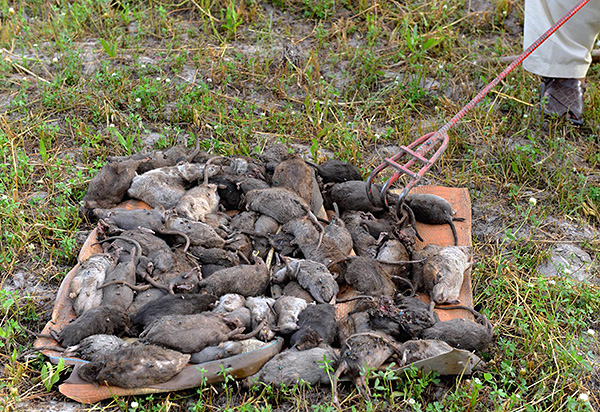
Why are so many people afraid of rats? What can be so terrible in a small nondescript animal, which, when meeting a person, first of all tries to escape? People are not afraid, for example, of moles or hedgehogs. Why, then, does the sight of a rat make many people panicky?
In fact, this fear is well-founded: rats are really dangerous for humans, and many of the risks posed by these animals pose a real threat to life.
First, rats are carriers of many diseases. Including those that in the past caused large-scale epidemics and even pandemics, and today, thousands of human lives continue to be claimed throughout the world. It is no wonder that over the centuries-old history of acquaintance with these pests, people have developed almost an instinctive rat fear.

So today, an ordinary mother begins to panic when she sees a red rash on her child’s body, because in the past many generations such rashes were a sign of deadly smallpox. And even if today this rash is in most cases a symptom of harmless diseases, the fear of it seems to be in the blood of the mother. Likewise, an ordinary city dweller, even not always knowing what exactly the rats are dangerous for, is afraid of their presence. Nevertheless, the history of many generations of his ancestors eloquently testifies that where these animals are many, there is a threat to life.
Secondly, rats can attack humans. Yes, these are not large predatory cannibals, they cannot be compared with sharks or tigers, but Every year, hundreds of thousands of rat bites are officially reported in the world. Moreover, the bites are not harmless, but can lead to infection or leave psychological trauma.

Thirdly, encounters with rats are dangerous to health, even if these animals do not infect humans. Today, musophobia is widespread - fear of rats, many people suffer from allergies to rat coat or excrement.
On a note
Rats can cause industrial accidents through their activities. This risk is usually paid little attention, but in vain. Remember the Fukushima accident in Japan in the spring of 2016? She almost became a disaster, comparable to the events in 2011! At the same time, it is believed that her culprit was just the same rat, gnawing wires in one of the switchboards. Due to a short circuit, a fire broke out, the entire cooling system of the station automatically stopped working, which almost led to the destruction of the reactor and radiation leakage. And the number of smaller accidents caused by rats and leaving without light, for example, a maternity hospital and a hospital, is huge around the world.
And yet, today many of the dangers posed by rats are greatly exaggerated. People like to scare themselves and each other, and for this they actively spread unverified rumors. As a result, some fears of these rodents are, if not illusory, then certainly not completely justified (for example, rumors of giant mutant rats in sewers that supposedly bite people to death).
We will not spread such rumors, but we will consider precisely those risks of the proximity to rats that are documented and which should be taken with full seriousness.
What diseases do rats carry?
To date, it has been proven that rats carry more than 20 viruses, bacteria and protozoa that cause disease in humans.

The most significant of them are:
- Plague - rats do not suffer from it, but carry its pathogen and are a natural reservoir for the plague stick. The plague wand itself is carried from them to humans by fleas that bite first rodents and then humans;
- Typhus endemic typhoid, also called flea, or rat. Its main difference from other forms of typhoid is that fleas are its carriers together with rats (most of the other forms are carried by lice and ticks);
- Tetanus is a deadly disease that can develop after being bitten by almost any animal, and rats are no exception;
- Leptospirosis, also known as "rat disease." It is usually transmitted by contact or alimentary: it can be infected through products spoiled by rats (mainly through liquid dishes, milk and meat), water, as well as through direct contact with an animal (for example, when removing its body from a trap);
- Sodoku is a specific disease, sometimes also called rat disease. It is transmitted by rodent bites, but cats or dogs that eat sick rats can become infected with it. After this, by the way, the bite of a cat or dog is also fraught with infection;

- Q fever - transmission of its pathogen occurs by inhalation, through inhalation of dust with excrement from sick rats, or through spoiled food;
- Pseudotuberculosis, which is transmitted to a person by an alimentary route (mainly through products infected with rat excrement);
- Visceral leishmaniasis, or black fever, is the most severe form of leishmaniasis, from which up to 50 thousand people die every year in tropical regions. The causative agent of it from rats to humans carry different types of mosquitoes;
- Cryptospiridiosis, spreading alimentary and deadly for patients with immunodeficiencies;
- Toxoplasmosis is a relatively mild disease that poses a threat mainly to the fetus in a sick pregnant woman. It is transmitted more often by an alimentary route, through the feces with which rats contaminate food;
- Creeping erythema, or erysipeloid, is a bacterial skin lesion. Most often occurs in housewives when working with products stained with feces of rats.
In addition, diseases transmitted by rats may be specific for different regions. For example, rats in the United States suffer diseases such as Colorado tick-borne and arenavirus fevers, in South America - Chapare and Venezuelan hemorrhagic fevers, in Africa - Lassa fever (with a mortality rate of about 30%), in Siberia - Omsk hemorrhagic fever.
Also in Russia, rats settling on agricultural land near human housing become carriers and an important reservoir for the causative agent of Lyme disease. Partly from this source, “ticks” are fed, which just infect people with lime borreliosis.
It should be borne in mind that rats can be infected with many infections, even if they do not see the rodents themselves, do not touch them, or even know that they live nearby. The rat can quietly swarm in the house or cellar, at night climb up on food, feed on them and stain them with their excrement. It is only necessary to prepare such products insufficiently - and the bacteria from them will be in the human digestive tract.
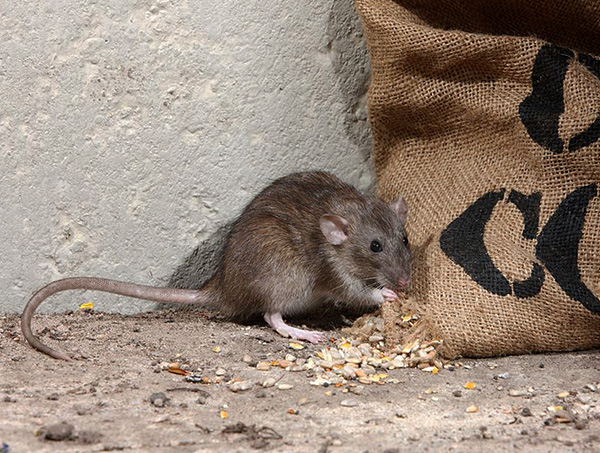
And fleas swarmed in the hair of rats constantly scatter their eggs around the animals, and they themselves often leave the body of the rodent in search of temporary shelter. Climb the rat briefly into the living room - and with a high probability there will be several parasites from its coat. And after a few days, getting hungry, they will begin to bite people, possibly rewarding them with various pathogenic microbes.
In this way, by the way, rats with fleas several centuries ago destroyed a third of the population of Europe ...
Plague from rats: in the Middle Ages, in the last century and today
According to historians, the bubonic plague pandemic that swept across the civilized world in the VI century AD killed more than 100 million people. Some experts believe that this outbreak was one of the reasons for the fall of the Roman Empire.
In the XIV century (until 1325), during the second pandemic in Europe, more than 25 million died of the plague.more than a third of its population, and the echoes of this outbreak swept through Russia, the Middle East and North Africa for several decades, taking hundreds of thousands of lives in different countries. And the rats also played a decisive role here.

In the XVIII century, during the reign of Empress Catherine the Great, more than 56 thousand people died from the plague in Moscow alone - it was precisely because of the disease that the famous “plague” rebellion broke out.
In the 19th century, a plague pandemic broke out in Asia, spreading from China. Her echoes swept across all continents. Then more than 10 million people died (of which about 6 million in India).
Finally, in the years 1910-1911, an outbreak of plague in Manchuria claimed the lives of more than 60 thousand people.
Today around the world annually about 2500 cases of plague are recorded. About 6-7% of them end in the death of patients.

As you can see, the plague is one of the worst diseases in the history of human civilization. And it was rats who introduced people to this infection.
On a note
It should be noted that the plague stick normally develops in the organisms of many rodents. Today, its main reservoirs in nature are wild settlements of gophers, gerbils and jerboas, and rats are infected with it to a much lesser extent than these animals. However, rats are the most dangerous for humans, since they live next to them and more often become a source of infection.
The causative agent of the disease from rats is transmitted to humans by fleas, mainly rats, less often cat, dog, human. All of them can change the owner and bite alternately either rats or people, but the bite of a rat flea is the most dangerous, since it is rats that are the main owners of this species. If different fleas are parasitic on one animal, then, due to the peculiarities of biology, it is rats that quickly displace all competitors.

Actually, the transfer of plague sticks from rats to humans occurs as follows:
- A flea sucks blood from a rat with a pathogen;
- Bacteria accumulate in the goiter of the insect without penetrating the stomach, multiply in huge quantities and clog the esophagus;
- At the next bite of a flea, it cannot swallow a portion of blood and burps a wad of mucus with plague bacilli in the wound. So there is an infection of a person or an animal.
Due to problems with swallowing blood, an infected flea is constantly hungry and often changes hosts. Therefore, the likelihood that she will try to feed herself on a person increases.
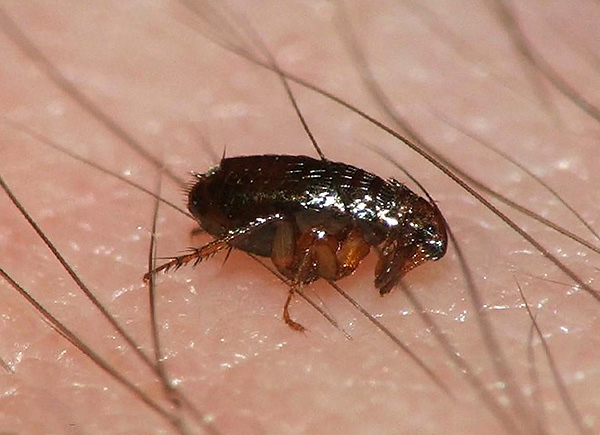
On a note
Despite the fact that mice are also a reservoir of plague, infection with this disease from them is extremely rare, since fleas parasitizing on mice practically do not attack humans. This means that in terms of plague infection, rats are much more dangerous than mice.
In Russia, only one case of the plague has been recorded in recent years: in 2016, a ten-year-old boy fell ill in Altai. Basically, the disease today occurs in tropical Africa and South America, rarely, but regularly, groundhog hunters in Kazakhstan, Central Asia and Mongolia are infected with it. The highest risk of an outbreak is where rats live in and near human housing, in contact with wild carriers of the infection.
Rat endemic typhoid
Other names for this disease are typhus endemic and flea endemic typhoid. Her symptoms are fever, headache, persistent temperature within 39-40 ° C, severe malaise and characteristic skin rashes.
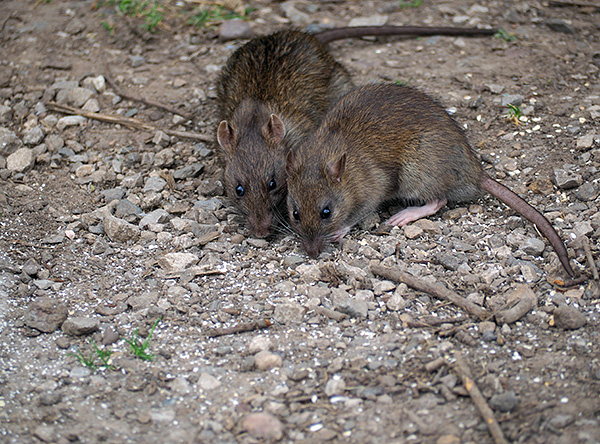
In severe cases, the meninges are involved in the pathological process with typhoid, which leads to one or another nervous disorder. In addition, the disease is dangerous due to complications in the blood vessels, which can cause myocarditis, thrombophlebitis, and cerebral hemorrhages.
Nevertheless, today rat endemic typhoid fever is successfully treated with affordable and inexpensive antibiotics, and its complications are prevented with the help of blood anticoagulants. Fatalities are rare and occur mainly in developing countries.
It is important that fleas are the carriers of rat typhus. Neither ticks nor lice can transmit this disease. The mechanism of transmission of its pathogen is not the same as with the plague: rickettsia does not penetrate the blood of a person with flea saliva, but simply is in its excrement. A person infects himself when combing a bite, while simultaneously crushing fleas that are left on the skin. Bacteria themselves penetrate micro-scratches on the skin, and from them into the blood, with which they spread throughout the body.
Sodoku: how dangerous is this disease?
Sodoku is a typical rat disease. Rodents themselves suffer from it and die from it, and they can infect a person with bites, since the pathogen is in the saliva and gets into the wound with it when biting the skin.
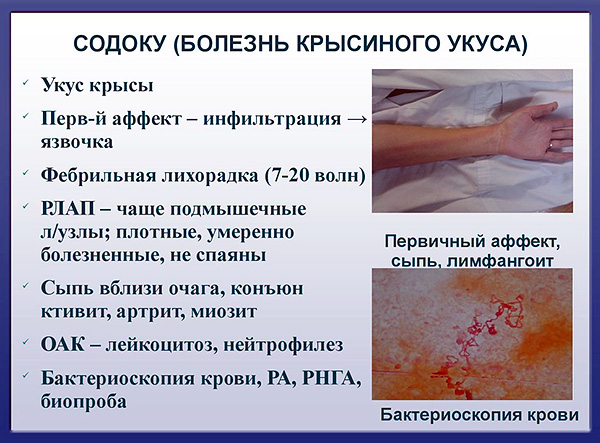
Symptoms of sodoku in humans: severe pain at the site of the bite, sometimes with suppuration or swelling; a few days after the bite, the temperature rises and muscle pains appear. Also, the victim may develop temporary mental disorders - impaired coordination of movements, severe arousal.
This rat disease is easily treated, its causative agent is sensitive to penicillin antibiotics, as well as to salvarsan and other drugs for syphilis. At the same time, in the absence of treatment, the mortality rate of the disease reaches 10%, and therefore, even at the first suspicious symptoms, it is necessary to consult a doctor as soon as possible.
Leptospirosis, or another rat disease
Today, WHO considers leptospirosis as one of the most important diseases that humans infect from animals. In particular, in Russia in the last century, leptospirosis was the most common disease transmitted from animals to humans. Its main feature is that pathogens - leptospira - are excreted from the body of rats with urine (a rather rare phenomenon), and the likelihood of infection remains until the urine itself dries (leptospira survives only in high humidity).

Leptospirosis is also transmitted through feces, and it can be infected from rats and mice (moreover, in some places mice are the main distributors of this infection), as well as from various farm animals. In cities, this is a typical rat infection. You cannot get leptospirosis directly from a sick person.
The main symptoms of the disease are fever, rash on the body, jaundice and hemorrhage in the conjunctiva of the eye. With leptospirosis, the heart, brain, and kidneys can be affected. The basis of treatment is antibiotic therapy (penicillins and macrolides are effective in case of illness), in severe cases, plasmapheresis and the administration of specific serum to the patient are prescribed.
According to medical statistics, in about half of cases, leptospirosis is so difficult that the patient has to be placed in intensive care.
Rat-borne fevers and their diversity
Rats are also carriers of infections that cause various fevers in humans. Among them are Congolese fever, Venezuelan fever, Chapare fever, Omsk hemorrhagic fever, Lass disease, and Ku fever.
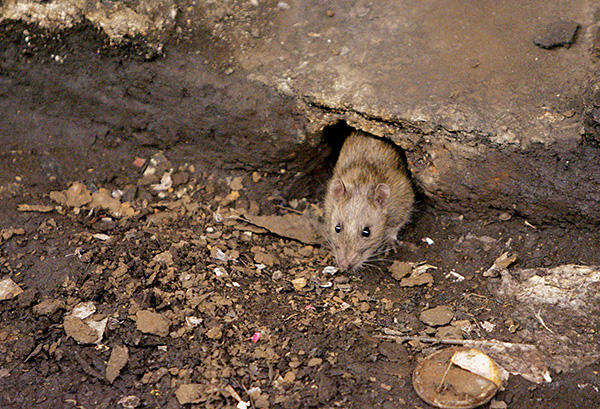
It is interesting that the causative agents of many of them are viruses, and only some (in particular, Q fever) are caused by bacteria. With the same Omsk fever, the virus from rats is transmitted in different ways:
- It is carried by infected ticks;
- Spreads with dust from dry rat excrement;
- It enters water in open water, and a person becomes infected when it is drunk.
Separate conversation deserves a fever Ku.Its pathogen is very stable in the environment, from mice and rats it is transmitted through excrement, through water and with wool, some ticks also carry it. Since the symptoms of this disease are very reminiscent of a typical ARI, it is sometimes mistaken for flu. So, in 2009 in Holland it was Ku fever that was mistakenly called goat flu (sometimes called “rat flu” in everyday speech).
It is gray rats in cities that are the main reservoirs of the causative agent of this disease.
On a note
Fever can be infected by direct contact with a sick or dead animal. If, for example, a child picks up a dead rat and plays with it, there is a risk of contracting it with an infection that will cause a fever. This fever is different from other diseases, the causative agents of which must be transmitted to the human digestive tract, or directly to the blood, for infection.
The most dangerous fever transmitted from rats is Lassa fever. It is known mainly in Central Africa, where up to 5,000 people die from it annually. The main way to transmit this disease is through contact; most people become infected by pulling rats out of traps in the fields and on farms. The picture below shows a poster informing that a child can become infected if he picks up the corpse of a rat and plays with it:
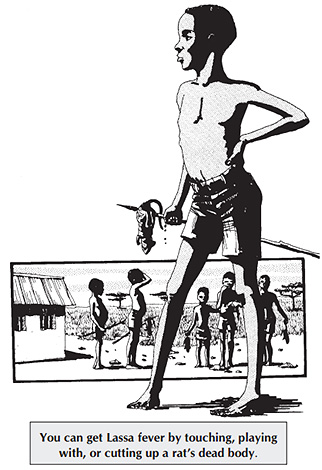
Can rats tolerate rabies?
To date, no cases of rat rabies are known. Hypothetically, rat rabies can exist, there are even theories that infected rodents die very quickly from this disease (within a few days), and therefore do not fall into the hands of scientists and do not have time to infect humans.
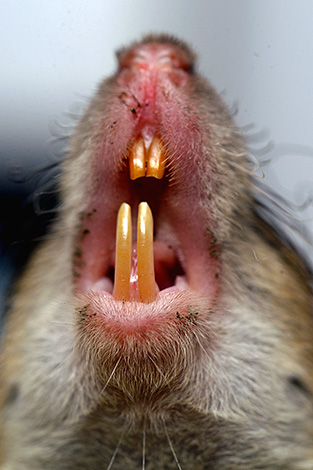
But the fact remains: rabies in rats and mice has never been detected. Isolated cases of alleged infection of people with this disease after bites of rats in Poland, Israel, Thailand and Suriname have been documented, but their small number does not allow us to talk about at least any systematic nature.
It is important not to confuse rabies and tetanus. Sometimes these names are considered as synonyms, especially since tetanus can also develop after animal bites. However, the development mechanism of tetanus itself is unique: its causative agent is present in the body of most animals and people, without harming the owner. It becomes pathogenic only in the absence of oxygen. In particular, in places of bites under the skin covered with dried blood, bacteria begin to produce a tetanus toxin - one of the most powerful toxins in nature - which leads to the development of the disease. That is, rats cannot tolerate tetanus, but this disease can develop after their bites.
Helminthiasis caused by rats and mice
There are few common types of helminths in humans and rats. There are two types of tapeworms that parasitize rats and can be dangerous for humans, as well as one species of trichinella, whose larvae, according to some studies, can also develop in the human body.
The photo below shows Trichinella:
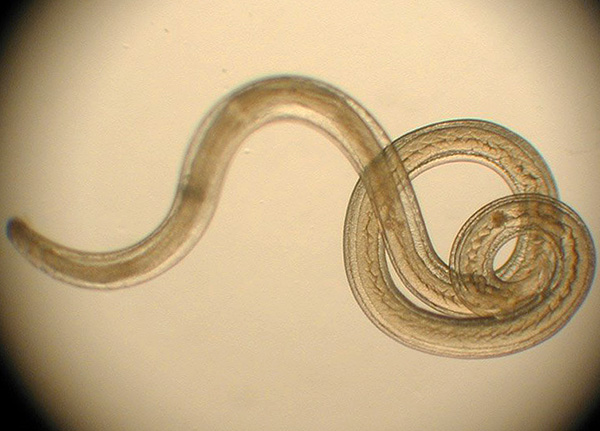
In fact, in developed countries there is no danger of helminth transmission from rats to humans. This is due to the fact that both tapeworms and trichinella enter the human body with the meat of the first owner. Simply put, in order to become infected with worms from a rat, you need to eat it, and before that, its meat should not be subjected to significant heat treatment, that is, it should be practically raw. For cultural reasons, this can only happen in very remote areas (for example, in tribes leading a semi-wild lifestyle).
Allergy to coat, urine, and rat excrement
Allergy to rats occurs at about the same frequency as allergies to other animals, and occurs with similar symptoms: sneezing, increased tearfulness, conjunctivitis, and allergic rhinitis.It can be caused by both rat hair and dry excrement, in rare cases, urine, and an allergy with the same probability can develop for both a domestic and a street rat.
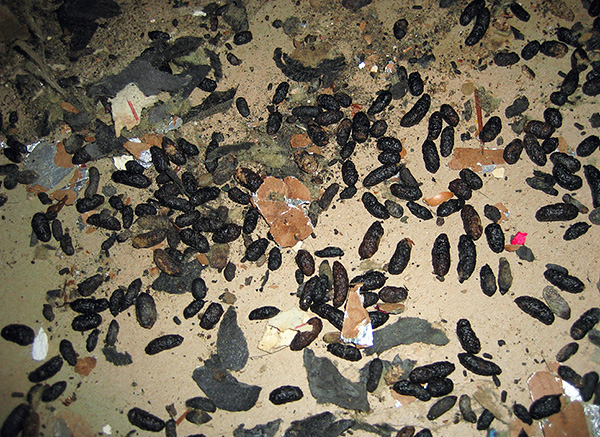
You can temporarily stop the symptoms of allergies with antihistamines or local hormonal agents - ointments, nasal sprays, tablets. A complete cure is possible only after a course of specific immunotherapy.
If an allergy has arisen on a street rat regularly climbing into the room, it is enough to simply get rid of it and thus eliminate the allergen itself.
On a note
Tetanus and allergies are the main dangers that a domestic rat poses to humans. She will not be able to infect her master with a "street" disease, but she is quite capable of grabbing her finger with blood or causing allergic rhinitis with her hair.
Rat bites and their danger
Rats are also dangerous because they often bite people. Recall that with such bites there is a risk of infection with soda and tetanus, but the rodent bite itself is very painful, often accompanied by bleeding. This is not surprising: with its jaws, a rat can develop a pressure of up to 500 kg / cm2, allowing her to gnaw copper and lead.
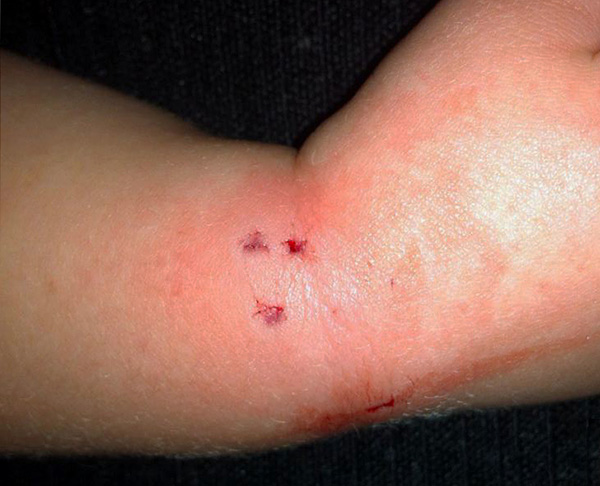
Bringing a human finger to the bone is not a problem for an adult rat. The bites themselves can suppurate when infected with an external bacterial infection, and without therapy ulcers often develop on the site of ulcers.
However, rats are bitten to blood mainly for self-defense, when they are caught or driven into a hopeless impasse. Very rare, but documented cases where these animals bit through the skin of sleeping people.
Often rats bite, being very hungry. In this case, they strive to nibble strong skin on the heels of humans, they bite large animals by the feet, and elephants can nibble their heels so that they cannot walk.
At the famous animal merchant Karl Hagenbeck, three elephants died in one night from the fact that rats nibbled their feet. Small animals - rodents, lizards and frogs, birds in nests - rats easily kill and devour. If this happens in a chicken coop or rabbitry house, then the harm from rats can be very serious.
Musophobia
This term refers to rat fear, or an unconscious and uncontrolled fear of rats and mice. It should not be confused with an aversion to rats, developing, rather, out of habit or because of the desire to follow generally accepted patterns of behavior. With musophobia, a person begins to panic at the sight of a rat, not being able to explain the reason for his fear and control himself.
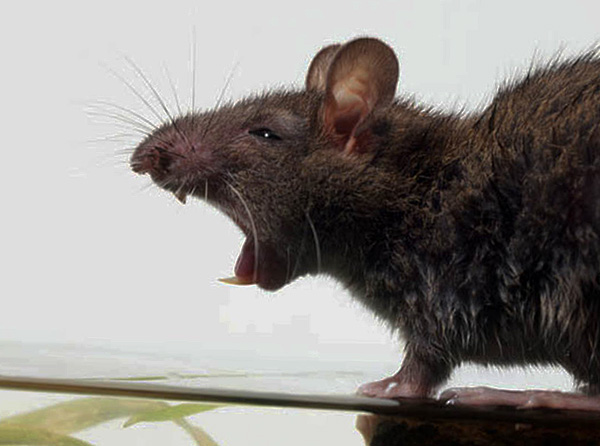
It is simple to identify this symptom: it’s enough for a person to show a neat decorative rat or mouse. If, at the sight of her, the patient begins to shake, then he really has a phobia. If it turns out that he is scared only by basement rats or only stories about mutant rats, then we are not talking about the disease, and the fear turns out to be far-fetched.
On a note
Musophobia should be distinguished from zemmophobia. The latter denotes the fear of moles, and a person suffering from it does not have to be afraid of rats.
Musophobia is treated with the technique of rapprochement, which in simple terms can be called "knock out a wedge." Simply put, the patient is shown rats, but at first they are cute decorative, preferably rats, perhaps in the videos, and then from afar and not for long, and then gradually reduce the distance and increase the duration of contact.
With a competent medical approach, musophobia can be completely eliminated.
The dangers of technogenic accidents caused by rats
Finally, the consequences of accidents caused by rats can be dangerous to humans. So, there are cases of breakthrough of dams due to the fact that rats literally riddled them with their holes. After that, houses located nearby were flooded.
And in 1989, half of New York sat for several hours without light, when the rat closed the contacts at the distribution station and, burning itself, set off a fire.Several lines were automatically turned off.

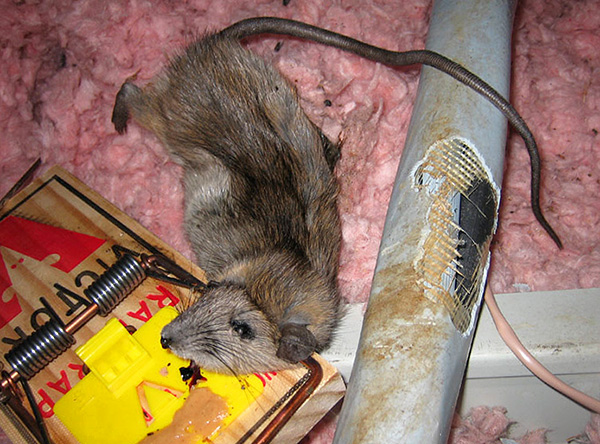
In the Renaissance chronicles, cases are reported when rats spoiled food on ships and the crew starved while on the high seas. And relatively recently, in one of the Chinese cities at the airport, the engine did not start at the plane due to the rat gnawing one of the hoses in the fuel supply system. It is not known how many victims this rodent could have caused, if he had gnawed the same hose during the flight ...
In any case, rats are very dangerous just because too many of them live next to us. Even if one in several hundred of them will be infected, among millions of animals in a big city, thousands will be infected. Even if one out of a thousand opens the way to a residential building or apartment, and already hundreds of people will eat spoiled foods, and then try to catch rodents. And a few home-grown lucky hunters will certainly be bitten ...
And you should always remember that the most dangerous rats are not mythical mutants the size of a dog, which in reality no one has ever seen. The real threat to humans is the fearful small inhabitants of basements and entrances, often literally stuffed with pathogens of infections dangerous to humans. You need to stay as far away from them as possible, and if you find them close to your home, carefully fight them.
Interesting video: 5 reasons to be afraid of rats
Cat attack on a brazen rat





Hello. Please tell me, if rat poison got into the human body and partners had sexual contact - can the poison be transmitted? Is it transmitted with saliva?
At first I wanted to poison, but there are concerns for myself? Women…